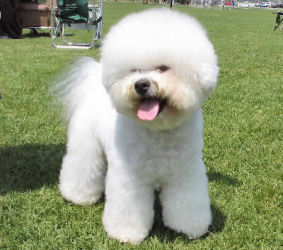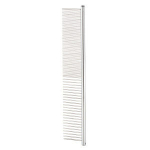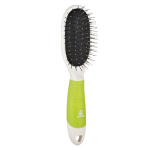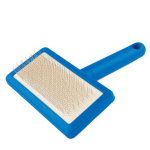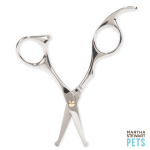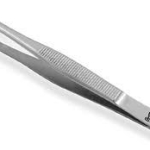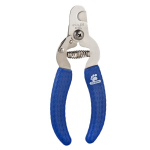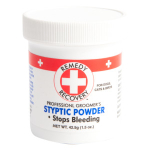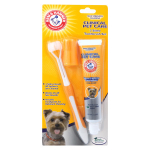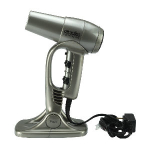The trademark of the Bichon Frise breed is their beautiful white “puffy” coat. Although the coat requires maintenance, grooming can be a special time of bonding between a pet and its owner. This has always been a very relaxing time for me and my Bichon. Some areas of grooming include bathing, brushing/combing, eye/ear care, and nail/teeth care.
Groom your puppy daily starting from the day that you bring puppy home. Bath as frequently as required (my bathing time for my dogs/puppies is on Fridays – everyone gets a bath). If you choose to groom your puppy on a table, don’t forget that puppies firmly believe they can fly so keep one hand on puppy at all times. A rubber car mat or rubber shelf liner on your work area makes a good non-slip grooming surface. You can purchase a grooming table in any Pet Catalog or Amazon. A shampoo specifically made for white-coated dogs will work great for your puppy – my favorite shampoo is E-Z Groom Crystal White Shampoo.
The tools of the trade will be a slicker brush and a long tooth comb (greyhound metal comb). Taking the slicker brush and remembering to keep the teeth of the brush level with which ever part of the dog you are grooming, very softly part and brush every part of the dogs coat taking great care to brush away from the eyes. Remember that knots will always occur in the following areas: between the front legs, between the back legs, around male dog testicles, behind the ears, and under the chin. If you do find a knot, hold the knot so that your fingers are between the knot and the skin and carefully tease the knot out.
This is my “Daily Ritual” for grooming my puppies:
Most puppies love having their coats brushed and combed. They are usually easy to handle if you are gentle, taking care to not pull their hair.
Check your puppy’s eyes and ears during the grooming process; the eyes should be clear and bright and the ears should be clean. It may be necessary to clip some hair within the ears if there is not a clear air passage. Pay close attention to the ears; if you notice any redness, swelling, or sensitivity to touch, contact your veterinarian immediately.
You should keep your puppy’s nails clipped to ensure good foot development. Let your veterinarian show you how to do this so you do not clip too much. If you clip too far back, you may cut a vein and make the nail bleed. Be sure to have a good, sharp nail clipper to do this job. If it makes you uncomfortable or your dog will not cooperate, you can have your veterinarian clip them for you.
The Bichon Frise is known as a high maintenance breed, which means that there is a lot of grooming needed. Because it takes time and practice to get the techniques correct, most pet owners rely on professional groomers to do the major bath and haircut that is needed about once a month. However, there are many tasks that can and should be done at home between visits to the groomer. We will discuss those and describe how they should be done, as well as list the tools that a Bichon owner needs to keep his pet’s coat, teeth, toenails and pads in good condition.
Tools you will need to care for your Bichon at home include:
A coarse-medium greyhound-type comb
Pin brush
Slicker brush
Scissors (these need to be dog grooming scissors)
Blunt tip tweezers
Toenail clippers
Styptic for treating bleeding toenails
Toothbrush, paste and scalers
Note: You will also need a hair dryer if you bathe the dog at home.
It pays to buy quality tools as cheap ones will destroy the coat.
Daily:
The most important daily tasks are brushing/combing through the coat to prevent matting and daily care of the teeth.
An adult Bichon’s coat is a double coat, meaning that there are both soft hairs and a coarser kind of hair, called guard hairs. The guard hairs are not present at birth. They begin to show up along the lower back just before the dog’s first birthday. You will find that a young pup does not mat often but you must start him off with daily combing to train him to accept this attention and to establish the habit early in his life that will be necessary as he reaches adulthood. You will begin by brushing through his coat with the pin brush, which will remove most of the small knots or beginning mats. Then his coat can be combed through for a final touch up. Find brushing instructions below. While you are brushing, be on the lookout for fleas, sores, lumps or other changes that need veterinary attention.
Just before his adult coat comes in, he will begin to mat very easily. While the Bichon does not shed, he (like his human owner) has a lot of dead hair that must be removed to prevent matting. In fact, it is because he does not shed this dead hair that it must be combed and brushed out. The closer he is to getting his double coat, the worse this will become and he may even need combing out twice a day! Dead hairs will form mats that, if neglected, are like felt and to remove them will require one of two drastic measures. Either the dog must be shaved to the skin or the mats must be broken up and removed, one by one, which is a very painful process. You should be aware that groomers usually charge more for a matted dog – as they should because of the work involved.
Weekly:
Check the teeth for buildup of tartar and remove.
Check the pads and toenails. Hair around the toe pads should be scissored away. Use a good pair of blunt nosed scissors and also remove any hair that has grown between the pads. This hair can collect debris and will form rock like knots if not removed periodically. Keeping the pads free of hair helps the dog to maintain traction as well as preventing sore feet.
Toenails should be clipped at least every other week. Check for the pink vein that runs the length of the toenail and clip just below the vein. If bleeding occurs, use a styptic to stop the bleeding. Your groomer or veterinarian can show you how to properly clip the toenails.
Monthly:
As mentioned above, the dog should be bathed and scissored at least once a month. It is okay to bathe more often and many owners schedule this to be done every two weeks. Emergency baths can be given (at home or by the groomer) even more often but it is important that the dog first be brushed free of any knots or mats. Wetting those mats will make the knots even tighter. If you do bathe him at home, use a shampoo for white dogs and rinse thoroughly. Human shampoos are the wrong pH for a dog and leaving soap in the coat will be harmful to the coat and may affect the skin.
Brushing the dog:
To properly brush the coat and for the comfort of the dog, he should learn to lie on his side. The basic idea will be to brush the hair up from the skin instead of down against the skin. On the head, the hair will be brushed toward the face, taking care not to stick the dog’s eye with the pins of the brush (I personally like to use a comb for all sensitive areas). Along the sides and back, brush upward toward the spine, with the dog lying on his side. Work through any mats or knots, using the end tooth of the comb to work them out. Start to work the knot at the end farther away from the skin and gently pull or work the knot loose from the outer to the inner portion of the knot. Needless to say, the sooner you discover the knot and work it loose, the easier it will be to remove it. Large mats will take infinite patience to break up.
The ears, tail and legs also have to be brushed and combed free of knots. The legs are actually where mats are more likely to form, especially on a dog that tends to chew or lick himself. Brush the legs, as with the body, by brushing up and out from the skin. With the ears, it is probably easier to brush the underside of the ear first and then to work on the outer side of the ear. Because ears and tail have longer hair, work on the ends and get them tangle free. Next move the brush up an inch or so nearer the body and remove any tangles there, until you are able to freely pull the brush the length of the hair from the skin outward. There are spray products available to help untangle the hair. You spray the area, work the spray into the coat and then proceed with brushing.
In using the end tooth of the comb to work out knots, you need to take care not to injure the skin, especially on older dogs. Take care in brushing not to damage the eyes and avoid getting sprays or shampoo into the eye. When bathing your dog, you need to also take care to keep water out of the ear canal and this can be done by using a bit of cotton in the ear during the bath.
The technique for brushing your dog applies to the dry coat, before bathing, as well as to brushing out the wet coat after a bath. If you are bathing the dog at home, he needs to be toweled as dry as possible and then to be completely brushed free of any mats you missed prior to bathing. Now the coat has to be blown dry, while brushing at the same time, to straighten the curl and to get the powder puff look of the Bichon. Very hot air will burn your dog’s skin so use a cooler setting! It is during the drying and brushing step that you will use the slicker brush. In other words, use the pin brush and comb on dry coat or immediately after the bath to work out knots. Use the slicker brush as a finishing brush to finish removing the curl. The slicker brush is NOT to be used to remove tangles because it will pull too much undercoat out and leave the beautiful plush coat looking thin and sparse.
Many pet owners do not understand how the Bichon trim should look. Even if you are having your Bichon professionally groomed, make sure your groomer understands the unique style of the Bichon trim.While a puppy or a pet adult can have a shorter haircut, the general outline and appearance of the newly groomed Bichon should look much the same as you see in photos. The tail should remain long and flowing, the ears, beard and mustache can be kept short but not be shaved or overly scissored. In other words, the Bichon Frise is a breed unto itself and your pet should not be trimmed to look like any other breed. This is NOT a poodle mix or a kind of terrier but it is a “white powder puff of a dog”. Proper grooming will make him look exactly as he should, whether he is in full show coat or a shorter pet trim.
